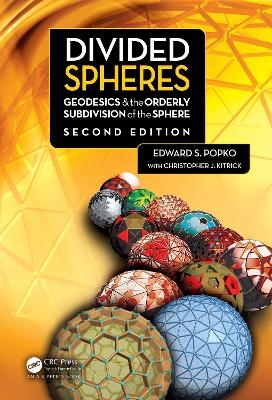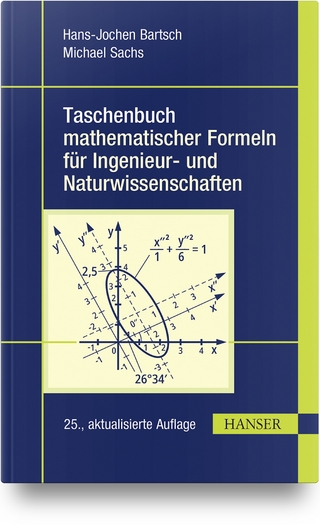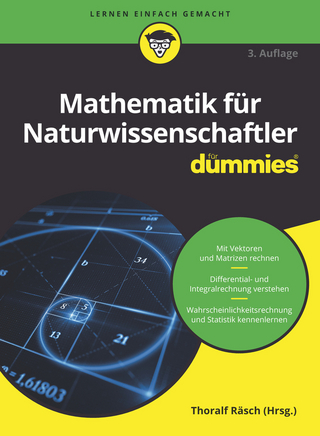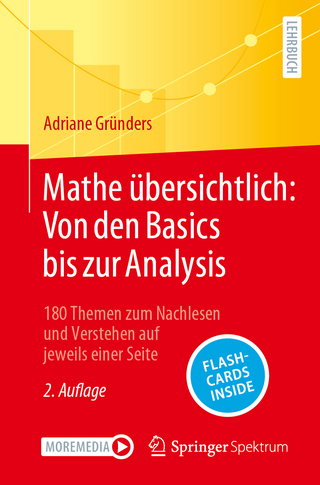
Divided Spheres
CRC Press (Verlag)
978-0-367-68074-9 (ISBN)
Praise for the previous edition
[. . .] Dr. Popko’s elegant new book extends both the science and the art of spherical modeling to include Computer-Aided Design and applications, which I would never have imagined when I started down this fascinating and rewarding path.
His lovely illustrations bring the subject to life for all readers, including those who are not drawn to the mathematics. This book demonstrates the scope, beauty, and utility of an art and science with roots in antiquity. [. . .] Anyone with an interest in the geometry of spheres, whether a professional engineer, an architect or product designer, a student, a teacher, or simply someone curious about the spectrum of topics to be found in this book, will find it helpful and rewarding.
– Magnus Wenninger, Benedictine Monk and Polyhedral Modeler
Ed Popko's comprehensive survey of the history, literature, geometric, and mathematical properties of the sphere is the definitive work on the subject. His masterful and thorough investigation of every aspect is covered with sensitivity and intelligence. This book should be in the library of anyone interested in the orderly subdivision of the sphere.
– Shoji Sadao, Architect, Cartographer and lifelong business partner of Buckminster Fuller
Edward Popko's Divided Spheres is a "thesaurus" must to those whose academic interest in the world of geometry looks to greater coverage of synonyms and antonyms of this beautiful shape we call a sphere. The late Buckminster Fuller might well place this manuscript as an all-reference for illumination to one of nature's most perfect inventions.
– Thomas T. K. Zung, Senior Partner, Buckminster Fuller, Sadao, & Zung Architects.
This first edition of this well-illustrated book presented a thorough introduction to the mathematics of Buckminster Fuller’s invention of the geodesic dome, which paved the way for a flood of practical applications as diverse as weather forecasting and fish farms. The author explained the principles of spherical design and the three classic methods of subdivision based on geometric solids (polyhedra).
This thoroughly edited new edition does all that, while also introducing new techniques that extend the class concept by relaxing the triangulation constraint to develop two new forms of optimized hexagonal tessellations. The objective is to generate spherical grids where all edge (or arc) lengths or overlap ratios are equal.
New to the Second Edition
New Foreword by Joseph Clinton, lifelong Buckminster Fuller collaborator
A new chapter by Chris Kitrick on the mathematical techniques for developing optimal single-edge hexagonal tessellations, of varying density, with the smallest edge possible for a particular topology, suggesting ways of comparing their levels of optimization
An expanded history of the evolution of spherical subdivision
New applications of spherical design in science, product design, architecture, and entertainment
New geodesic algorithms for grid optimization
New full-color spherical illustrations created using DisplaySphere to aid readers in visualizing and comparing the various tessellations presented in the book
Updated Bibliography with references to the most recent advancements in spherical subdivision methods
Edward S. Popko is a graduate of the University of Detroit’s School of Architecture and has both Masters and PhD degrees from Massachusetts Institute of Technology. He is a registered architect and former Fulbright Scholar. In the 1960s, he was an apprentice in Buckminster Fuller’s affiliate office, Geometrics, Inc., in Cambridge, Massachusetts, and later authored Geodesics, a primer on geodesic domes, and Transitions, a documentary of urban settlements in developing countries. For the past 25 years, he has held research, product development, and marketing positions for Computer Aided Design and Geographic Information Systems technology within IBM. He has managed software development teams in computer mapping and CAD solutions for architects, industrial buildings, high‐tech plants, and shipbuilding. He is retired from IBM and lives with his wife, Geraldine, in Woodstock, New York. They have a daughter Ellen and a son Gerald. Christopher J. Kitrick is a graduate of the University of Cincinnati with a bachelor's in Architecture and a masters in Structural Engineering. In the late 1970s he interned for 3 years at Buckminster Fuller's professor emeritus office on the campus of the University of Philadelphia. During that tenure he was involved in Fuller's Synergetics II book, multiple dome developments, tensegrity research, and the first computerized version edition of the Dymaxion Air‐Ocean map. For the past 36 years he has been involved with graphics software and hardware development from mainframe to mobile devices enabling the rapid advancement of visual technology. Independently he has authored and presented numerous technical papers on spherical geometry at international conferences on space structures. He is still working and resides in La Jolla, California, with his wife Tomoko. They have two sons Francis and Ian, and one daughter, Eileen.
1. Divided Spheres. 1.1. Working with Spheres. 1.2. Making a Point. 1.3. An Arbitrary Number. 1.4. Symmetry and Polyhedral Designs. 1.5. Spherical Workbenches. 1.6. Detailed Designs. 1.7. Other Ways to Use Polyhedra. 1.8. Summary. Additional Resources. 2. Bucky’s Dome. 2.1. Synergetic Geometry. 2.2. Dymaxion Projection. 2.3. Cahill and Waterman Projections. 2.4. Vector Equilibrium. 2.5. Icosa’s 31. 2.6. The First Dome. 2.7. Dome Development. 2.8. Covering Every Angle. 2.9. Summary. Additional Resources. 3. Putting Spheres to Work. 3.1. The Tammes Problem. 3.2. Spherical Viruses. 3.3. Celestial Catalogs. 3.4. Sudbury Neutrino Observatory. 3.5. Cartography. 3.6. Climate Models and Weather Prediction. 3.7. H3 Uber’s Hexagonal Hierarchical Geospatial Indexing System. 3.8. Honeycombs for Supercomputers. 3.9. Fish Farming. 3.10. Virtual Reality. 3.11. Modeling Spheres. 3.12. Computer Aided Design. 3.13. Octet Truss Connector. 3.14. Dividing Golf Balls. 3.15. Spherical, Throwable Panʘnʘ ™ Panoramic Camera. 3.16. Termespheres. 3.17. Space Chip’s™. 3.18. Hoberman’s MiniSphere™. 3.19. V-Sphere™. 3.20. Gear Ball - Meffert's Rotation Brain Teaser. 3.21. Rhombic Tuttminx. 3.22. Rafiki’s Code World. 3.23. Japanese Temari Balls. 3.24. Art and Expression. Additional Resources. 4. Circular Reasoning. 4.1. Lesser and Great Circles. 4.2. Geodesic Subdivision. 4.3. Circle Poles. 4.4. Arc and Chord Factors. 4.5. Where Are We? 4.6. Altitude-Azimuth Coordinates.
4.7. Latitude and Longitude Coordinates. 4.8. Spherical Trips. 4.9. Loxodromes. 4.10. Separation Angle. 4.11. Latitude Sailing. 4.12. Longitude. 4.13. Spherical Coordinates. 4.14. Cartesian Coordinates. 4.15. ρ ɸ λ Coordinates. 4.16. Spherical Polygons. 4.17. Excess and Defect. 4.18 Summary. Additional Resources. 5. Distributing Points. 5.1. Covering. 5.2. Packing. 5.3. Volume. 5.4. Summary. Additional Resources. 6. Polyhedral Frameworks. 6.1. What Is a Polyhedron? 6.2. Platonic Solids. 6.3. Symmetry. 6.4. Archimedean Solids. 6.5. Circlespheres and Atomic Models. 6.6. Atomic Models. Additional Resources. 7. Golf Ball Dimples. 7.1. Icosahedral Balls. 7.2. Octahedral Balls. 7.3. Tetrahedral Balls. 7.4. Bilateral Symmetry. 7.5. Subdivided Areas. 7.6. Dimple Graphics. 7.7. Summary. Additional Resources. 8. Subdivision Schemas. 8.1. Geodesic Notation. 8.2. Triangulation Number. 8.3. Frequency and Harmonics. 8.4. Grid Symmetry. 8.5. Class I: Alternates and Ford. 8.6. Class II: Triacon. 8.7. Class III: Skew. 8.8. Covering the Whole Sphere. Additional Resources. 9. Comparing Results. 9.1. Kissing-Touching. 9.2 Sameness or Nearly So. 9.3. Triangle Area. 9.4. Face Acuteness. 9.5. Euler Lines. 9.6. Parts and T. 9.7. Convex Hull. 9.8. Spherical Caps. 9.9. Stereograms. 9.10. Face Orientation. 9.11. King Icosa. 9.12. Summary. Additional Resources. Subdivision Schemas. Geodesic Math. 10. Self-Organizing Grids. 10.1. Reduced Constraint Networks. 10.2. Symmetry. 10.3. Self-Organizing - Key Concepts. 10.4. Hexagonal Grids. 10.5. Rotegrities. 10.6. Future Directions. 10.7. Summary. Additional Resources. A. Stereographic Projection. B. Coordinate Rotations. C. Geodesic Math. Bibliography. Index.
| Erscheinungsdatum | 15.03.2022 |
|---|---|
| Zusatzinfo | 42 Tables, black and white; 491 Line drawings, color; 76 Halftones, color; 276 Illustrations, color; 291 Illustrations, black and white |
| Verlagsort | London |
| Sprache | englisch |
| Maße | 178 x 254 mm |
| Gewicht | 453 g |
| Themenwelt | Mathematik / Informatik ► Mathematik ► Allgemeines / Lexika |
| Mathematik / Informatik ► Mathematik ► Geometrie / Topologie | |
| Technik ► Umwelttechnik / Biotechnologie | |
| ISBN-10 | 0-367-68074-2 / 0367680742 |
| ISBN-13 | 978-0-367-68074-9 / 9780367680749 |
| Zustand | Neuware |
| Informationen gemäß Produktsicherheitsverordnung (GPSR) | |
| Haben Sie eine Frage zum Produkt? |
aus dem Bereich


